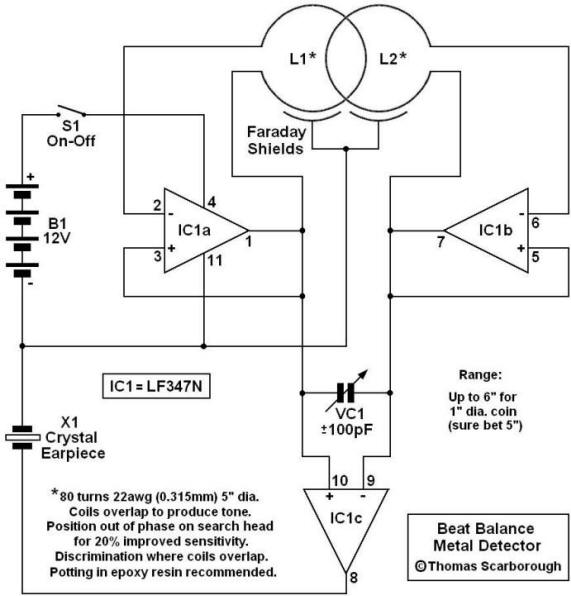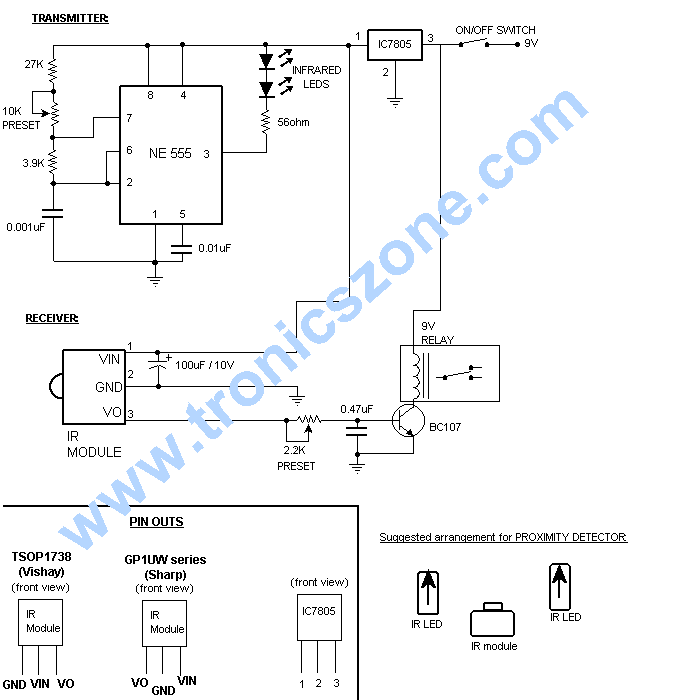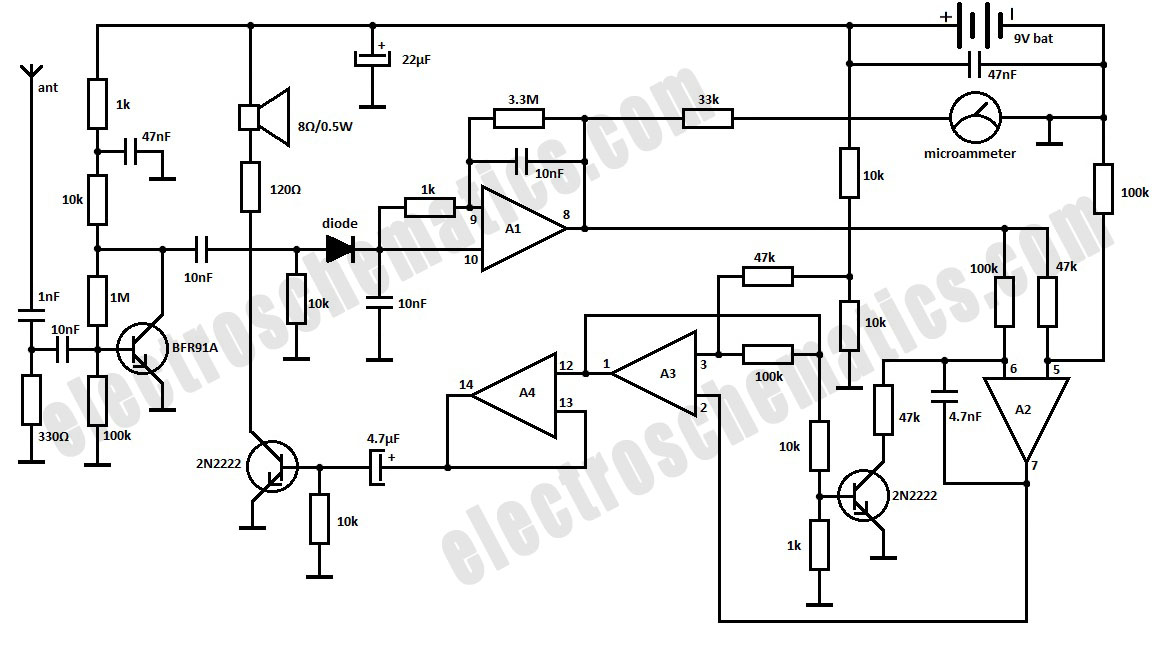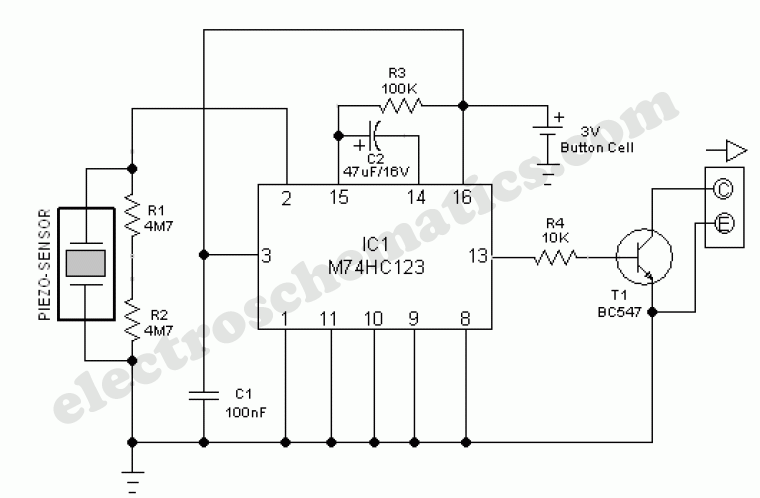
Air-motion detector
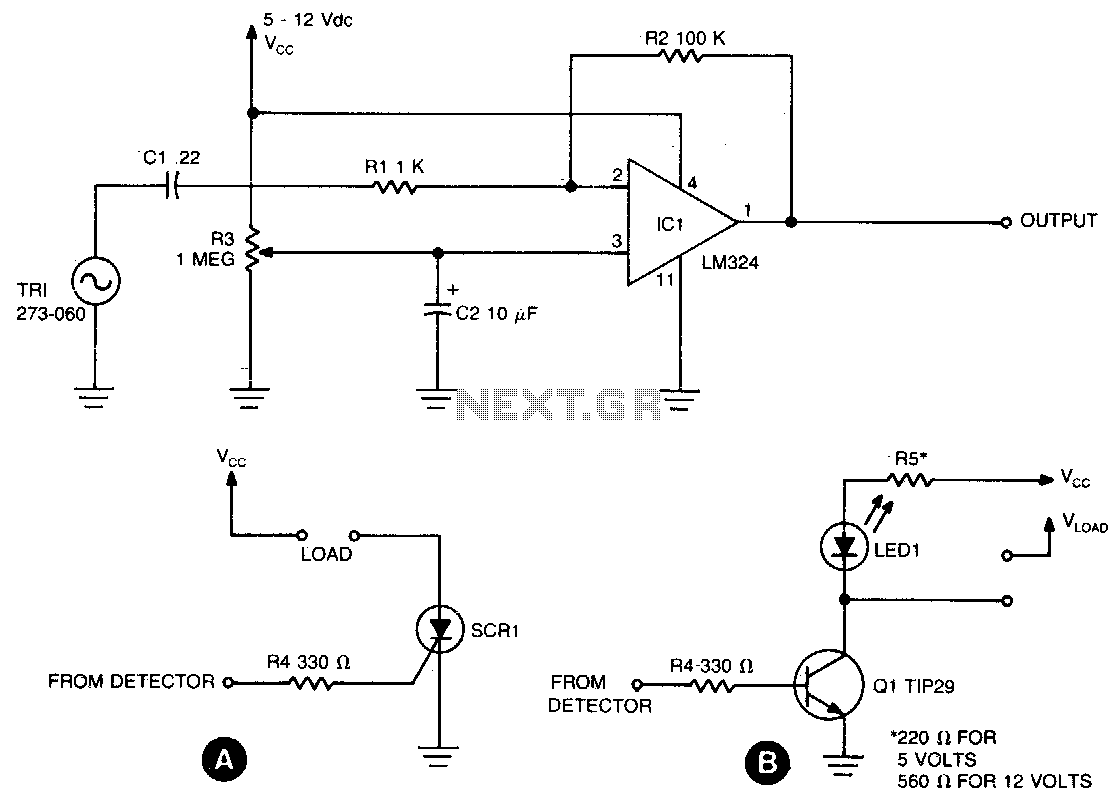
The sensing circuit is designed to detect both steady and fluctuating air flows. It utilizes a Radio Shack piezo buzzer (P/N 273-060) as its core component, along with an LM324 quad op-amp. The red wire from the piezo element connects to capacitor C1, while the black wire connects to ground. When air flows over the piezo element, it generates a small signal that is transmitted through C1 and resistor R1 to the inverting input (pin 2) of one section of the LM324. This action causes the output at pin 1 to go high. Resistor R3 is employed to adjust the circuit's sensitivity.
The circuit can be finely tuned to detect subtle movements, such as the wave of a hand, or set to a lower sensitivity where even a strong blow on the element results in no output. Resistor R2 is utilized to adjust the output voltage level at pin 1. This detector circuit can be applied in various control applications. For instance, a silicon-controlled rectifier (SCR) can be implemented to manage 117-volt AC loads, as illustrated in schematic A. Additionally, an NPN transistor like the TIP29 can be used for load control, as shown in schematic B.
The sensing circuit operates by converting mechanical vibrations from air flow into an electrical signal. The piezo buzzer acts as a transducer, converting the kinetic energy of air movement into a voltage signal. The capacitor C1 serves to filter and smooth the signal before it reaches the op-amp, ensuring that only significant changes in the signal are amplified. The LM324, being a quad op-amp, allows for multiple configurations and uses, making it versatile for various applications.
The sensitivity adjustment via R3 allows the user to calibrate the circuit based on the specific environment or application requirements. This feature is particularly useful in applications where the detection of minor air movements is necessary, such as in security systems or automated control systems.
The output from pin 1 of the LM324 can interface with various types of loads. The SCR option provides a means to control high-voltage AC loads, suitable for applications like lighting control or motor operation. In contrast, using an NPN transistor like the TIP29 enables the control of lower voltage DC loads, making the circuit adaptable for different types of devices. Overall, this sensing circuit offers flexibility and reliability in air flow detection and control applications.Sensing circuit detects either steady or fluctuating air flows. The heart of the circuit is a Radio Shack piezo buzzer (P/N 273-060) and an LM324 quad op amp. (Red wire from the piezo element connects to capacitor CI, and the black wire to ground) When a current of air hits the piezo element, a small signal is generated and is fed through CI and R1 to the inverting input (pin 2) of one section of the LM324. That causes the output (pin 1) to go high. Resistor R3 adjusts sensitivity The circuitcan be made sensitive enough to detect the wave of a hand or the sensitivity can be set so low that blowing on the element hard will produce no output. Resistor R2 is used to adjust the level of the output voltage at pin 1. The detector circuit can be used in various control applications. For example, an SCR can be used to control 117-volt AC loads as shown in A. Also, an NPN transistor, such as a TIP29, can be used to control loads as shown in B.
The circuit can be finely tuned to detect subtle movements, such as the wave of a hand, or set to a lower sensitivity where even a strong blow on the element results in no output. Resistor R2 is utilized to adjust the output voltage level at pin 1. This detector circuit can be applied in various control applications. For instance, a silicon-controlled rectifier (SCR) can be implemented to manage 117-volt AC loads, as illustrated in schematic A. Additionally, an NPN transistor like the TIP29 can be used for load control, as shown in schematic B.
The sensing circuit operates by converting mechanical vibrations from air flow into an electrical signal. The piezo buzzer acts as a transducer, converting the kinetic energy of air movement into a voltage signal. The capacitor C1 serves to filter and smooth the signal before it reaches the op-amp, ensuring that only significant changes in the signal are amplified. The LM324, being a quad op-amp, allows for multiple configurations and uses, making it versatile for various applications.
The sensitivity adjustment via R3 allows the user to calibrate the circuit based on the specific environment or application requirements. This feature is particularly useful in applications where the detection of minor air movements is necessary, such as in security systems or automated control systems.
The output from pin 1 of the LM324 can interface with various types of loads. The SCR option provides a means to control high-voltage AC loads, suitable for applications like lighting control or motor operation. In contrast, using an NPN transistor like the TIP29 enables the control of lower voltage DC loads, making the circuit adaptable for different types of devices. Overall, this sensing circuit offers flexibility and reliability in air flow detection and control applications.Sensing circuit detects either steady or fluctuating air flows. The heart of the circuit is a Radio Shack piezo buzzer (P/N 273-060) and an LM324 quad op amp. (Red wire from the piezo element connects to capacitor CI, and the black wire to ground) When a current of air hits the piezo element, a small signal is generated and is fed through CI and R1 to the inverting input (pin 2) of one section of the LM324. That causes the output (pin 1) to go high. Resistor R3 adjusts sensitivity The circuitcan be made sensitive enough to detect the wave of a hand or the sensitivity can be set so low that blowing on the element hard will produce no output. Resistor R2 is used to adjust the level of the output voltage at pin 1. The detector circuit can be used in various control applications. For example, an SCR can be used to control 117-volt AC loads as shown in A. Also, an NPN transistor, such as a TIP29, can be used to control loads as shown in B.

